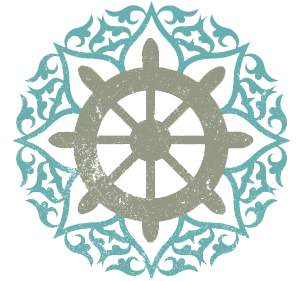
Our wheel in the logo is inspired by the Dharma wheel. This comes from the teachings of Buddha and is usually displayed with eight spokes symbolizing the noble eightfold path to liberation. "Dharma Chakra" धर्मचक्र means life wheel. "Dharma" means order, teaching. "Chakra" means wheel.
The wheel hub stands for the stability of the discipline. The wheel rim symbolizes the state of consciousness that holds everything together. It should also remind you that after death only the body dies and the mind changes into a different form. Each spoke stands for one of the eight paths to liberation - liberation from valuation. Only knowledge can people set free from evaluation by a condition free of suffering, greed, hatred, rage, and other bad feelings.
The Dharma wheel can also be seen in the flag of India.
THE EIGHT PATH
1. Right understanding
The knowledge of suffering, which is good and what is bad for us. Know the causes of suffering, the overcoming of suffering and the way to it. It is not an intellectual or analytical understanding, but an intuitive, deep understanding. It is said to be the understanding of reality as it is. It is not about understanding a philosophical system, but about understanding one's own life.
2. Right thinking
Is it a salutary thought, a thought that gives me and the other good or an unhealthy thought, a thought which gives me and other misfortunes or sufferings? In meditation, the mind lingers on nothing. It does not pursue and reject them. In that way thinking creates no opposition between itself and the others. The Right Thinking in the way of Buddha is a complete openness to the other, which makes the expression of an unconditional love that does not depend on what others give to us. This is a love that does not transform into hatred, hostility and jealousy, but brings with it real compassion. Compassion means feeling and sharing the pain of others.
From the Talmud: Pay attention to your thoughts, for they become words. Watch your words, for they become actions. Watch your actions, because they become habits. Watch your habits, for they become your character. Watch your character, for it becomes your destiny.
3. Right speech
Right speech is to distance ourself from untruths, not to lie to others and not to lie, and to refrain from saying bad things about others. One must not only pay attention to what one says, but also, as one says. After all, it is also about avoiding chatter, superfluous talk. In France, there is a saying that one should first turn his tongue eight times in the mouth, that means, that one should look at his motive before saying anything. If the subject is bad, it is better to be silent. The wrong word can be a real weapon and seriously hurt. Language can do a lot of things and many of them are even not aware of it.
4. Right action
Do not take a life, do not steal and do not give yourself any excess. It means not to act out of greed, not to act because you want to get something just for yourself, and not even from hostility and hatred towards others.
5. Right way of life
To pursue a profession that does not harm other living creatures. In addition, it is understood that, no matter what you do, you always work with the idea in the mind, to keep the money not only for yourself, but to share with others. The right way of life allows us to maintain our body, with which we practice - the house of our soul.
6. Right striving
Try hard to live a good life and do not have to put all your effort on more and more. Checking your thoughts and exchanging unhealthy thoughts with salutary thoughts. If you do not want to make an effort, it is very difficult to change yourself. We remain a slave to our habits, which become ever stronger and rob us of our freedom.
7. Right mindfulness
Take care that we live in harmony with the world in thoughts and deeds. Mindfulness towards the "outside" is to be completely in the here-and-now, not to follow the past and not to revel in the future. The practice of observation is to observe our body, observe our tensions and let go, observe our breathing, deepen the exhalation and become conscious of our feelings and emotions, observe how they appear and disappear. And the activity of our mind to observe, observe how it tries to seize as it has the tendency to reject. How it constantly moves between taking and rejecting, and also how it can be exploited and deceived by our illusions. How it has the tendency to be scattered, and how it constantly fled the here and now.
8. Right sinking
The way to the inner sinking (meditation) to equanimity, serenity, clarity and despair. It always contains the components of concentrated, mental orientation and inner peace and serenity. Everyone who has once seriously tried to meditate will have learned how jumpy and confused the thoughts and emotions were. As opposed to normal awareness, meditation offers a protected exercise space to observe, or to exercise, one's own mind, thoughts, and emotions. As the practice progresses, the meditator learns to become aware of his ego, his normal thoughts and patterns of thought, at every moment of meditation, and let go of this piece by piece. This enables him to look at situations of objective, detached, in the exercise of the mental collection. Or he strengthens the mindfulness to the moment, without being constantly blocked and distracted by thoughts and emotions.
STEERING WHEEL
As a second meaning, the wheel stands also for the steering wheel, which will navigate and guide us through the world. It also means that we move through life and from country to country, depending on changing conditions.

